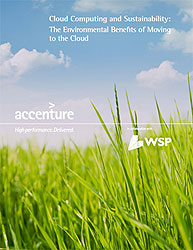REDMOND, Wash. – Nov. 4, 2010 – The benefits of cloud computing – reduced costs, increased storage, and better flexibility, to name a few – have been widely trumpeted in recent years as more companies transition to the cloud.

The new study found that companies running applications in the cloud can reduce their carbon emissions by 30 percent or more compared with running those same applications in their own infrastructure.
Add “smaller carbon footprint” to the list.
A new study released today found that companies running applications in the cloud can reduce their carbon emissions by 30 percent or more compared with running those same applications in their own infrastructure. The study, “Cloud Computing and Sustainability: The Environmental Benefits of Moving to the Cloud,” was commissioned by Microsoft and conducted by Accenture, a global management consulting, technology consulting and technology outsourcing company, and WSP Environment & Energy, an environmental consulting group.
The findings provide supporting evidence on the cloud’s environmental benefits, which until now had been guesswork, said Rob Bernard, chief environmental strategist at Microsoft.
“The IT industry had this nagging question – as more and more services move to the cloud, do they consume more or less energy?” Bernard said. “This study found that you can migrate existing infrastructure to the cloud and see not only growth in productivity but a reduction in energy consumption for those services.”

Rob Bernard, chief environmental strategist at Microsoft.
The study was aimed at understanding how the cloud performs differently from an on-premises environment, said Josh Whitney, corporate sustainability strategy lead with WSP. Using a methodology aligned to the Global eSustainability Initiative (GeSI) standards, Accenture and WSP compared the energy use and carbon emissions per user for Exchange Server 2007, SharePoint Server 2007, and Microsoft Dynamics CRM with their cloud-based equivalents: Exchange Online, SharePoint Online and Microsoft Dynamics CRM Online. The results suggest that for widely deployed and commonly used applications such as e-mail, content sharing and customer relationship management, the cloud can enable significant reduction in carbon emissions.
“The findings are actually pretty impressive,” Whitney said. “I think this study provides further reinforcement of the benefits of the cloud beyond the bottom line. It provides one of the first quantitative and measurable analyses of the impact that cloud computing can have directly compared to a traditional deployment of IT within a company.”

Josh Whitney, corporate sustainability strategy lead with WSP Environment & Energy
The study assessed the environmental footprint of server, networking and storage infrastructure for three different deployment sizes: small deployments of 100 users, mid-sized deployments of 1,000 users, and large deployments of 10,000 users. Whitney said that across the board, companies reduced energy consumption and carbon emissions when they deployed their applications in the cloud. Small businesses saw the most dramatic reduction in emissions – up to 90 percent. Large corporations can save at least 30-60 percent in carbon emissions using cloud apps, and mid-size businesses can save 60-90 percent.
“Essentially what you have happening here is similar to driving private automobiles versus riding on public transportation,” Whitney said. “Everyone driving cars on the highway is similar to the inefficiency of an on-premise environment as opposed to taking mass transit, which is effectively the public cloud.” He noted however, that “unlike mass transit, there aren’t any tradeoffs for using the cloud.”
The study pointed to several other factors that drove down emissions and consumption, including the fact that datacenters operate servers at much higher utilization rates and are physically constructed to reduce power loss.
Mike Ehrenberg, a technical fellow and chief architect for Microsoft Dynamics, said the study’s findings should reinforce for customers the benefits of moving to the cloud. “One thing we focus on is giving customers choice, and, particularly with Dynamics CRM 2011, we can really give them the same capability and flexibility in the cloud as we can on-premise,” he said. “Now, when they turn around and ask, ‘Which one is right for me?’ we have this study that shows a benefit they probably wouldn’t have thought about with cloud deployment, which is sustainability benefit.”
Bernard said the future holds even more promise than those documented in the study.
“In addition to the carbon savings that were found through the study, I’m even more excited about the new kinds of applications that will be developed in the cloud that drive new efficiencies across industries including smart grids, buildings and transportation,” he said. “We will continue to experience efficiency gains over time with computing, and the potential is there for the cloud to have a significant impact and replace activities that have high carbon intensity.”




